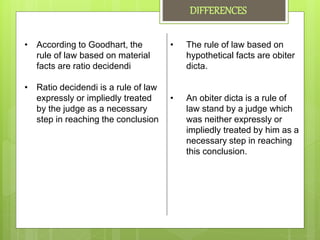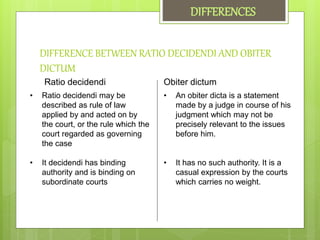Explain Difference Between Ratio Decidendi and Obiter Dicta
2 They are also observations on legal. This provides anj opportunity to the judge to mould the law according to changed circumstances.

4 Major Differences Between Ratio Decidendi And Obiter Dicta With Example Multiple Khoj
Ratio decidendi refers to the legal principle laid down in a judgment while Obiter dicta refers to any passing remarks made by a judge in a judgment which is not necessary for or not related to the decision of the judgment.

. Ratio Decidendi 1 It means the reason for the decision. Volume 15 April 2021 ISSN 2581-5504. For example ratio decidendi refers to the facts of the case those things that no one can debate.
Obiter dicta literally translates to things said in passing. However an obiter dictum may be of persuasive as. Obiter dicta translates to by the way and refers to information that a.
This ratio decidendi has to be determined by the judge and he has to apply it to the facts of a case which he is going to decide. As per the hierarchy rule a judicial precedent made by the Supreme Court must be followed by every other court within the territory of India which is regulated as per Article 141. As it is already discussed that ratio decidendi and obiter dictum are two contents of judgment it is pertinent for us to understand which one of these parts is binding in case a precedent is raised in the court of law.
Such an obiter may not be a binding precedent. Dicta are legal principles or remarks made by. A judges expression of opinion uttered in court or in a written judgement but not essential to the decision and therefore not legally binding as a precedent.
Technically apart from the findings of material facts a decision can flow from two basis one ratio decidendi and the other being obiter dicta. These are vital to the courts decision itself. Ratio decidendi Obiter Dicta and Stare Decisis 1.
The traditional view is that we have to differentiate between the ratio decidendi of a judgement which will be the binding part and the obiter dicta which will be the non-binding part. The ratio decidendi is also known as the rationale for a decision. Difference Between Ratio Decidendi and Obiter Dicta.
Ratio decidendi is the Latin term meaning the reason for the decision and refers to statements of the critical facts and law of the case. DIFFERENCE BETWEEN RATIO DECIDENDI AND OBITER DICTUM DIFFERENCES Ratio decidendi Obiter dictum Ratio decidendi may be described as rule of law applied by and acted on by the court or the rule which the court regarded as governing the case It decidendi has binding authority and is binding on subordinate courts An obiter dicta is a statement. Obiter Dicta It means things said by the way.
The Other meanings are the rule of law which others regard as being of binding authority. Ratio Decidendi means the reason of the decisions which not only binds parties but also forms as law to the future generations. Distinguish between ratio decidendi and obiter dicta.
An obiter dictum is not binding in later cases because it was not strictly relevant to the matter in issue in the original case. Ratio decidendi are the reasons behind the decision given by the court. Obiter dicta often simply dicta or obiter are remarks or observations made by a judge that although included in the body of the courts opinion do not.
While obiter dicta has no binding force. It is the principle orrule of law. Ratio decidendi has referential value to be cited as precedent in other cases whereas Obiter dicta can be ignored as the personal.
Obiter Dicta 1 They are they said in passing. The general rules of Ratio Decidendi and Obiter Dicta also come within the ambit of Article 141. Statements that are not crucial or which refer to hypothetical facts or to unrelated law issues are obiter dicta.
This is also known as Doctrine of Stare Decisis. A judicial statement can be ratio decidendi only if it refers to the crucial facts and law of the case. Apply well-established rules to identify the ratio decidendi in a decision.
Obita dicta are not binding unlike the ratio but they may be regarded as persuasive in a future decision. Therefore it is an important part of a judgement in the interests of this and is the potentially binding part of a judgement. In the judicial context it is the reason which is cited for arriving at a decision in a case.
Statements which are not part of the ratio decidendi constitute obiter dicta and are not authoritative. The main difference between ratio and obiter dicta is the information under scrutiny. An obiter dictum as distinguished from a ratio decidendi is an observation by the Court on a legal question suggested in a case before it but not arising in such manner as to require a decision.
The ratio decidendi of a judgement is often looked at when deciding if a party can rely on the judgement for precedent in future cases. Rationes is the reason for a judges decision in a case. The binding part of a judicial decision is the ratio decidendi.
Ratio Decidendi and Obiter Dicta. In order to make sense of this statement we must not only analyse what we mean by ratio decidendi and obiter dictum which is the singular of obiter dicta but must also consider more precisely. Ratio decidendi of a judgment may be defined as the principles of law formulated by the Judge for the purpose of deciding the problem before him whereas obiter dicta means observations made by the.
If you are certain that you understand how to discover the ratio in an opinion you should. The basis of a decision. 3 rows A judicial statement of what we commonly refer to as a judgement in a legal case consists of two.
The ratio is the judges ruling on a point of law and not just a statement of the law. This module is intended as a useful exercise in revision. Ratio decidendi and obiter dicta Learning objectives At the end of this module you will be able to.
Obiter dicta is a Latin phrase meaning things said by the way. Obiter dicta are additional observations remarks and opinions on other issues made by the judge. But the obiter dictum is the normal statement that may help one in understanding the circumstances which led to the decision of the court.
The weight given to dicta usually depends on the seniority of the. The ratio decidendi plural. Obiter dicta is a remark made by a judge which forms no part of the reasoning that is directly responsible for the verdict called the rationes decidendi also called simply the ratio.
Generally obiter dictum is not binding. What is the difference between ratio and obiter. Ratio decidendi is a rule of law expressly or impliedly treated by the judge as a necessary step in reaching the conclusion.
1 Ratio decidendi 2 Obiter dicta. The Rules of Obiter Dicta. Obiter dicta on the other hand is everything in between.
Except the High Courts seriously considered dicta is binding. These often explain the courts rationale in. Ratio decidendi literally means reason for deciding.
It is the statement of law which is not strictly relevant to the facts of the case and goes beyond. An obiter dictum is a rule of.

Judicial Precedent The Doctrine Of Precedent Ppt Video Online Download


No comments for "Explain Difference Between Ratio Decidendi and Obiter Dicta"
Post a Comment